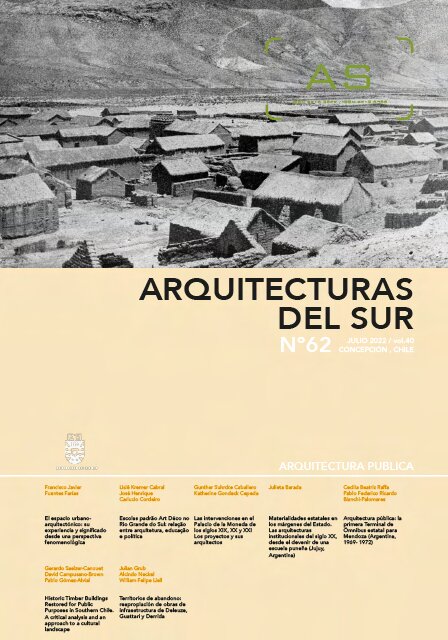Interventions at La Moneda Palace, from the 19TH, 20TH, and 21ST centuries. The projects and their architects
DOI:
https://doi.org/10.22320/07196466.2022.40.062.03Keywords:
Joaquin Toesca, restoration, reconstruction, contemporary interventions, organized recordAbstract
The Palacio de La Moneda, or La Moneda Palace, is the seat of the Presidency and the Executive Power of Chile, the Ministry of the Interior and Public Security, the General Secretariat of the Presidency, and the General Secretariat of the Government. It is one of the main historical and most important buildings in Chile in terms of its current representative function, as the Government Palace. Since its construction, in 1786, it has been the witness and star of the historical-political and social-urban evolution of the nation, of events that have been expressed in its own architectural metamorphosis and the evolution of the urban fabric. Designed by architect Joaquín Toesca, a disciple of Francesco Sabatini, a professional of the court of Carlos III, King of Spain (1759-1788), the Palace is the main example of Neoclassicism in Chile. It was inaugurated in 1805 as the Royal Mint of Santiago, to mint the kingdom's currency. After the independence of Chile, in 1845, the Seat of Government and Presidential Residence moved to the building. It is on this date that it adopts its representative function, and therefore, the moment where the first important modification of its floorplan took place, beginning a process of continuous evolution characterized by the dynamic transformation and permanent adaptation of its architecture, through successive interventions, functional updates, and its reconstruction after the 1973 air raid. The lack of an organized and detailed record of its permanent alterations makes it difficult to understand them from their current state and for possible future interventions. As a result, this article presents the most important and significant changes on the perception of the building, thus becoming the first organized record of contemporary interventions of La Moneda Palace.
Downloads
References
ALEGRÍA, J., CAMPOS, E., RODRÍGUEZ, H. y SACAAN, J. (1983). Palacio de la Moneda. Santiago: Dirección de Bibliotecas, Archivos y Museos.
BAEZA, F. (1981). Arquitectura y servicios públicos. Revista CA, (29), 2-11. Recuperado de http://revistaca.cl/revistas/029.pdf.
BINDA y MINIÑO. (1999). Informe técnico preliminar Palacio de La Moneda. Santiago: Presidencia de la República.
CASTRO, R. (2006). Santiago Republicano.cl: Rescate del patrimonio visual de la ciudad de Santiago, a través de un sitio web de ilustraciones digitales con códigos contemporáneos, basadas en vistas panorámicas realizadas desde el cerro Santa Lucía entre 1855 y 1867 por T. R. Harvey, James Melville Gillis y Pedro Dejean. Proyecto para optar al título profesional de diseñador gráfico. Universidad de Chile. Recuperado de https://repositorio.uchile.cl/bitstream/handle/2250/100763/Santiago%20Republicano.pdf?sequence=3&isAllowed=y.
DARM MOP (2014). Vestigios, memoria visual: De la arquitectura al relato social de Chile. Santiago, Chile: Ministerio de Obras Públicas.
DARM MOP (2016). Obras de conservación Palacio de La Moneda, Ala sur. Santiago, Chile: Ministerio de Obras Públicas.
Departamento de Patrimonio Cultural de Presidencia de la República de Chile (2015). Plan maestro gestión del patrimonio cultural Palacio de La Moneda. Santiago: Presidencia de la República.
Departamento de Patrimonio Cultural de Presidencia de la República de Chile (2017). Fondo conjunto de cooperación Chile-México sobre patrimonio cultural en casas de gobierno Palacio de La Moneda. Santiago: Presidencia de la República.
Enterreno Chile (2016). Recuperado de https://www.enterreno.com/moments/patio-de-los-naranjos-en-1971.
GREVE, E. (1938). Historia de la Ingeniería en Chile. Tomo II. Santiago: Imprenta Universitaria.
GUARDA, G. (1997). El arquitecto de La Moneda Joaquín Toesca 1752-1799: Una imagen del imperio español en América. Santiago: Ediciones Universidad Católica de Chile.
GUENEAU DE MUSSY, L. y LÓPEZ, C. (2012). La Moneda. Palacio de Gobierno de Chile. Santiago: Universidad Finis Terrae.
MÁRQUEZ, F. y ROZAS-KRAUSE, V. (2014). Las heridas de la memoria. Disputas patrimoniales en el Palacio de la Moneda, Chile. Cuadernos de Antropología Social, (40), 149-176. Recuperado de http://www.scielo.org.ar/pdf/cas/n40/n40a07.pdf.
Memoria Chilena (2018). Perspectiva Palacio de La Moneda, 1821. Recuperado de http://www.memoriachilena.gob.cl/602/w3-article-99565.html.
OLIVA, H. (2017). Reconstruyendo La Moneda. La Tercera. Recuperado de https://www.latercera.com/noticia/reconstruyendo-la-moneda/.
PEÑA, J. (2013). Morandé 80 y monumento de Salvador Allende: Marcas territoriales de memoria del pasado reciente en Chile (2000-2011). Tesis de pregrado en Sociología. Universidad de Chile. Recuperado de http://repositorio.uchile.cl/bitstream/handle/2250/113979/cs39-penaj1180.pdf?sequence=1&isAllowed=y.
PERAL, J. (1999). Sociedad. Patrimonio. Modernidad. Consideraciones sobre la contemporaneidad. Legado e intervenciones. Revista PH, (28), 110-115.
PIROTTE, S. (1973). Palacio de La Moneda. Informe Bibliográfico. Santiago: Universidad de Chile.
Presidencia de la República (2015). Plan Maestro Presidencia de la República. Santiago: Presidencia de la República.
Presidencia de la República. (2017). Fondo conjunto de cooperación Chile-México sobre patrimonio cultural en casas de gobierno Palacio de La Moneda. Santiago, Chile: Departamento de Patrimonio Cultural, Presidencia de la República de Chile.
VALENCIA, N. (2018). Clásicos de Arquitectura: Palacio de La Moneda / Joaquín Toesca. Plataforma Arquitectura. Recuperado de https://www.plataformaarquitectura.cl/cl/896521/clasicos-de-arquitectura-la-moneda-joaquin-toesca.
Downloads
Published
How to Cite
Issue
Section
License
Copyright (c) 2022 Gunther Suhrcke-Caballero, Katherine Gondeck-Cepeda

This work is licensed under a Creative Commons Attribution-ShareAlike 4.0 International License.
The content of the articles published in each issue of Arquitecturas del Sur is the sole responsibility of the authors and does not necessarily represent the opinion of University of the Bío-Bío.
The authors will maintain their copyright; however, they will guarantee the journal the right to first publication and dissemination of their work. The publication of the article in Arquitecturas del Sur will be subject to the Creative Commons International license (CC BY-SA) that allows others to adapt: remix, transform and build on the material for any purpose, even commercially; share: copy and redistribute the material in any medium or format, as long as the authorship and first publication in this journal are acknowledged by citing them correctly, and their new contributions are under a license with the same terms.














 Programa de Información Científica/Concurso Fondos de Publicación de Revistas Científicas 2018/ Proyecto Mejoramiento de Visibilidad de Revistas UBB (Código:FP180007)
Programa de Información Científica/Concurso Fondos de Publicación de Revistas Científicas 2018/ Proyecto Mejoramiento de Visibilidad de Revistas UBB (Código:FP180007) 
